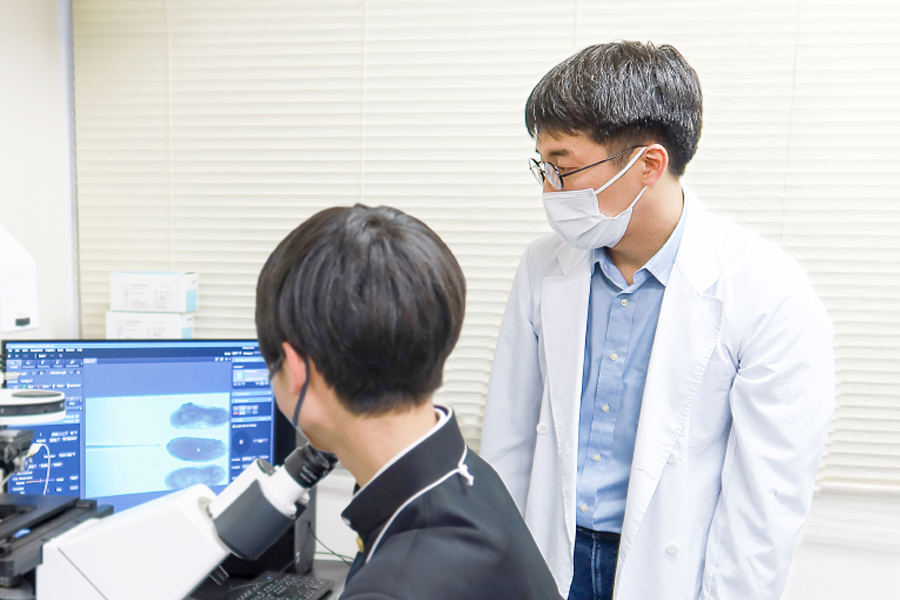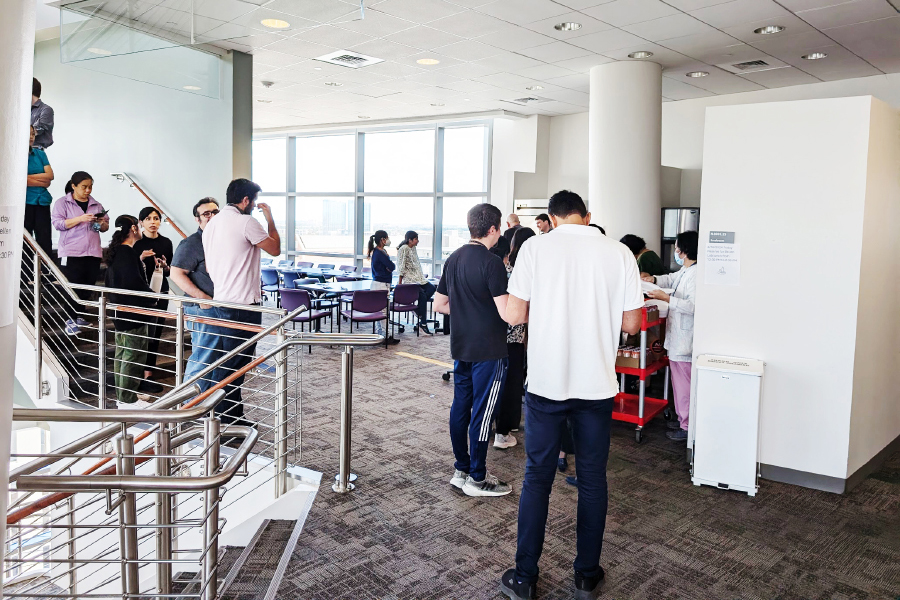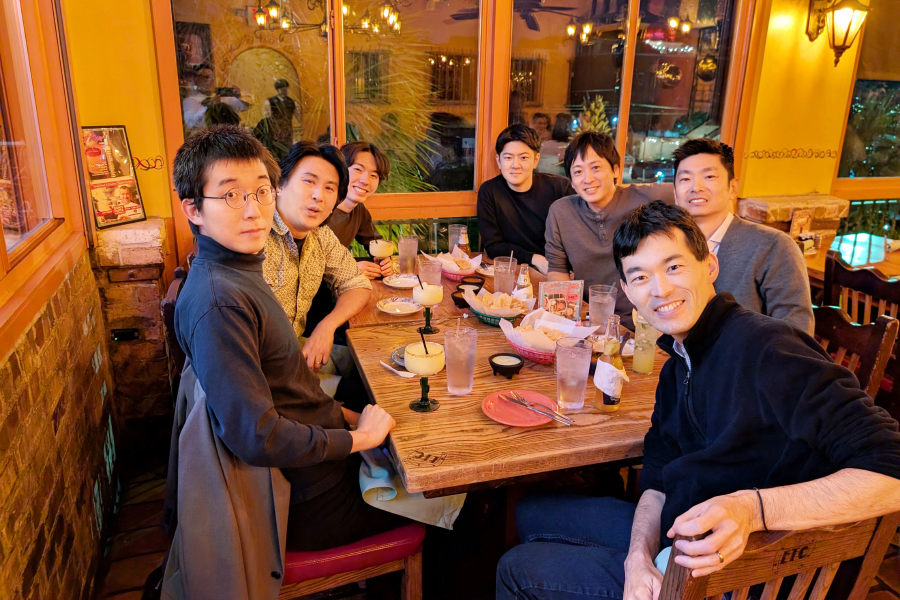
Baylor College of Medicine, USA
Yohei Nitta
Interview
Please share your career journey and how you came to connect with BRI.
I have consistently worked with Drosophila throughout my career. As an undergraduate at the Faculty of Agriculture, Tokyo University of Agriculture and Technology, I studied apoptosis. In graduate school at the University of Tokyo, I conducted functional analyses of novel genes involved in neurodevelopment, focusing on the effects of abnormal lipid metabolism on neural development.
As I was nearing the completion of my degree and considering my next career step, Dr. Atsushi Sugie, a senior member of my graduate school laboratory, invited me to join his newly established lab at BRI as a postdoctoral fellow. His research theme greatly interested me, and I decided to accept the opportunity, beginning my postdoctoral work in his lab.

at BRI
What research did you do when you were at BRI?
For seven years, from 2017 to 2024, I was a Grant-in-Aid for Scientific Research Fellow, a JSPS Research Fellow (PD), and later a Specially Appointed Assistant Professor in the Sugie Lab, where I conducted the following research using Drosophila.
1. Development of an Experimental System for Evaluating Axon Toxicity
During my research on neurodegeneration, I recognized the need for a precise and quantitative experimental system. To address this, I collaborated with corporate researchers to develop MeDUsA, a software program designed to quantify axonal numbers.
2. Mutational Analysis of Opa1, the Causative Gene of Dominant Optic Atrophy (DOA)
Using MeDUsA, we analyzed Opa1 mutations, which vary in severity depending on the mutation type. Previously, no established method existed for distinguishing these mutations. Our experimental system has now enabled their identification for the first time.
3. Identification and Functional Analysis of Novel Disease Mutations
Through collaborative research with both internal and external researchers, we identified numerous novel disease mutations. Notably, as part of the Undiagnosed Disease Initiative (IRUD), we conducted functional analyses of genetic variants of unknown significance (VUS). This work further underscored the utility of Drosophila as a model for disease research.
Before joining BRI, my research focused purely on basic science. However, working in an environment where clinical and basic researchers collaborate closely--alongside interactions with researchers from Niigata University's School of Medicine and School of Health Sciences--led me to reconsider the role of Drosophila in disease research.

Farewell party at Bellen Lab
Tell us about your current research.
During my graduate studies, I researched the relationship between lipid metabolism and neurodevelopment, and at Niigata University, I focused on neurodegenerative diseases. Through my work, I came to realize the strong connection between lipid metabolism abnormalities and neurodegenerative diseases. This led me to further explore the topic, drawing my attention to Hugo Bellen Lab at Baylor College of Medicine in the Texas Medical Center (TMC) in Houston, Texas, which was conducting similar but cutting-edge research using Drosophila. Their work investigates the parallels between Drosophila and the human body, providing valuable insights into disease mechanisms.
Prof Hugo Bellen leads the Drosophila sector of the Undiagnosed Disease Network (UDN), the U.S. counterpart to IRUD. I saw this as an ideal environment to integrate my research interests in lipid disorders and neurodegenerative diseases with VUS analysis using Drosophila, allowing me to build on my past experience and expertise.
I am currently working on several projects. In Alzheimer's disease, it is known that lipids produced in neurons form lipid droplets in glial cells. I am screening which genes among those identified as risk factors by GWAS are involved in the formation of these lipid droplets. In Parkinson's disease, lipid exchange between neurons and glial cells also occurs, and I am investigating the underlying molecular mechanisms. Additionally, I am analyzing VUS using the technology and expertise I gained at BRI.
Sometimes, these projects are pursued independently, while at other times, I collaborate with researchers both inside and outside the lab. Every day, I dedicate myself to my research, though I often find myself navigating the challenges of working in English.

A view of TMC, where snow fell for the first time in four or five years, leading to the university closing for two days.
Could you describe the research environment in your new country? Have you noticed any differences or similarities compared to Japan?
As expected, I am often impressed by the abundance of research funding. In addition to the NIH grants, which are equivalent to Japan's Grant-in-Aid for Scientific Research, there are numerous donations from various foundations and individuals. Many halls and buildings on campus are named after these donors. However, I was surprised to find that not all of the experimental facilities and equipment are state-of-the-art.
On the other hand, there are many postdoctoral fellows in every lab, and they are the backbone of research. These postdocs come from diverse backgrounds: some, like myself, specialize in Drosophila research, others are experts in bioinformatics, some have worked as doctors in their home countries, and others have experience working with mice. I've found that discussions among postdocs with such varied expertise often lead to breakthroughs in research.
Another striking issue, unique to the U.S. (or Texas), rather than the research environment itself, is the fragility of the infrastructure. Power outages can occur as soon as winds and rain intensify. Last summer, a direct hit from a hurricane left us without electricity and water for two to three days. This winter, we experienced our first snowfall in four or five years, causing the university to close for two days.
Although I am the only Japanese in our lab, there are many Japanese postdoc fellows at TMC, and a study meeting is held once a month. Fortunately, this helps me feel connected and supported, allowing me to focus on my research without feeling lonely.

Dinner with Japanese researchers
What is your future plan? / What are your goals for the future?
My goal is to elucidate the physiological functions of lipids in the brain. Although lipids account for 60% of the brain's dry weight, their functions remain poorly understood. This is largely due to technical challenges, such as the fact that lipids are not directly translated from genes like proteins, but are also involved in metabolic pathways in the reverse direction, complicating analysis. Additionally, only a few lipids can be labeled with antibodies, making it difficult to visualize their localization. However, with recent advancements in analytical techniques such as mass spectrometry imaging and Raman microscopy, the visualization and quantification of lipids have become more accessible. My immediate goal is to gain proficiency in lipid analysis techniques in my current lab and to clarify one aspect of the relationship between lipids and neurodegeneration. Subsequently, I aim to elucidate the roles and localization of various lipids in nerve formation and function, ultimately establishing a new field of research--"lipid neurology"--to comprehensively understand the functions of lipids in the nervous system.





